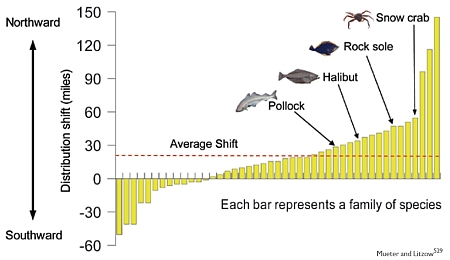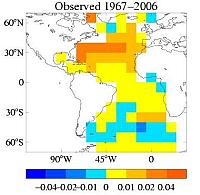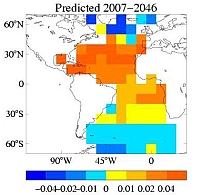4. Invasive Species in the Ocean
Effects of climate change on the distribution of marine alien species
Climate change will affect marine and coastal systems in a number of ways. The main aspects are
- altered thermal regimes (warmer water temperatures in most cases),
- shorter duration of ice cover,
- altered stream flow regimes (due to changes in precipitation patterns),
- increased salinity (due to increased air temperatures which in turn result in higher evaporation rates), and
- increased water-development activities in the form of canal and reservoir construction.
All of these may affect the living conditions of invasive species in the oceans and in coastal aquatic systems such as rivers, canals and reservoirs. Some effects of a changing climate are beneficial for the spread of invasive species; others may stop them from thriving in new habitats.
The figures below are an example of a predicted increase in ocean salinity due to climate change.
Salinity changes in the Atlantic Ocean, averaged over the top 500 meters of seawater.
Oranges represent increases in salinity; blues indicate decrease in salinity.
Left: Observed trends, 1967-2006, which show freshening at high latitudes and increases in salinity at lower latitudes.
Right: Predicted trends for 2007-2046.
These are some of the effects that climate change may have on marine species:
- Warm water-indigenous species may expand their ranges to the warming higher latitudes and out-compete cold-adapted
species through their greater growth and recruitment.
- Successful invaders tend to be more resilient to disturbances than native species, and thus climate change could
combine with other stresses to allow invaders to out-compete native species.
- The reduction of cold temperatures and/or winter hypoxia that currently prevent survival of many species could
improve their viability.
- The increased water demand will most certainly lead to the construction of reservoirs which in turn serve as hotspots for invasive species.
The figure below shows an example of an observed shifting of marine species that is most likely due to climate change.

Marine species of Alaska shifting northward between 1986 and 2006.
As air and water temperatures rise, marine species are moving northward, affecting fisheries, ecosystems, and coastal communities that depend on the food source. On average, by 2006, the center of the range for the examined species moved 19 miles north of their 1982 locations.
Source: Mueter and Litzow 2008


